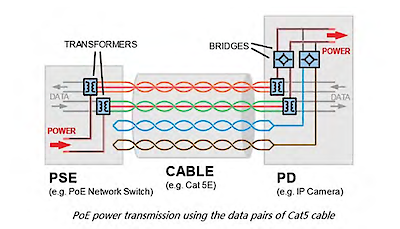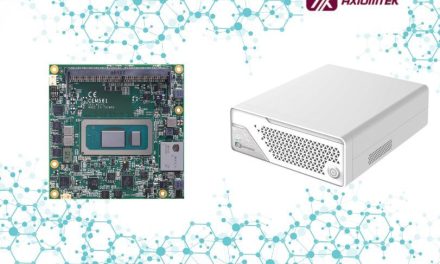The convergence between factory-floor and enterprise networks continues to be a contested area, with various technology players and investments challenging to gain the high ground. However, a technology that is becoming pervasive across enterprise, manufacturing and industrial sites is Power over Ethernet, as it expands the positive benefits of using a single network for data and power.

Figure 1. PoE general layout.
Power over Ethernet (PoE) is an Ethernet-compatible technology created to enable Voice over IP (VoiP) telephony. DC power, at a nominal voltage of 48 VDC, is carried on one or more pairs in the Ethernet cable along with the transmitted data signal. PoE-powered devices negotiate with the power source (e.g., PSE, typically a network switch) to ensure appropriate power is delivered. Businesses have acknowledged the potential of network supplied power as PoE is increasingly powers IP cameras, wireless access points, badge readers and access gateways, as well as lighting (Figure 1).
Today, PoE in industrial networks performs identical tasks to those it performs in enterprise networks. These tasks include powering shop floor phones, wireless access points, and IP cameras.

Table 2. Power over Ethernet Power Levels.
PoE is a key technology for the future of industrial networks because, with the advent of IEEE 802.3bt, conspicuous amounts of power can be delivered along the Ethernet connection to a device. With between 60W and 100W available at the end of an Ethernet cable, device manufacturers can be creative. This allows device power and communications in a single connection, simplifying all phases of the device life cycle. In doing so, PoE alters the DC power infrastructure of control systems. When this supporting infrastructure is eliminated, control system DC power infrastructure is simplified, and costs become lower.
PoE negotiates with the device at start-up to determine the appropriate power level to deliver. There is no need for pre-configuration of each circuit in a standards-compliant installation. Additionally, since device power is controlled by PoE-enabled ports in the switch above it, toggling device power can be done via network switch commands, simplifying service procedures. PoE should figure prominently in new network installations to simplify power needed by devices like cameras and wireless access ports and will have a transformative effect on the DC power infrastructure.
Single Pair Ethernet
Work is underway in IEEE 802.3 to develop standards for Single Pair Ethernet (SPE). Many variants are proposed from short reach (15 to 40m at 1 Gb/s transmission speed) to extreme lengths (up to 1km at 10 Mb/s transmission speed), all over a shielded twisted pair cable. For industrial network applications, the variant to watch is IEEE 802.3cg, the 1km at 10 Mb/s variant. All variants of SPE are considering a methodology for power delivery like PoE called Power over Data Line (PoDL), IEEE P802.3bu.
Single Pair Ethernet drives Ethernet-to-the-edge and is a vital measure of legacy protocol migration plans. For 802.3cg, its 10 Mb/s transmission speed provides more than enough bandwidth for end device and sensor data rates. For industrial networks:
• The reach objective of up to 1km is ideal for plants with large footprint, (e.g., oil and gas, petrochemical, vehicle manufacturing, etc.)
• Power delivery via the Ethernet connection achieves the aforementioned “one wire ideal” where device power and communications are enabled by a single connection – Given the power delivery aspect, it is conceivable that end device power infrastructure is greatly simplified by SPE
• SPE, being standard, unmodified Ethernet, supports purpose-built Ethernet forms like EtherNet/IP and ProfiNet without issue
• SPE can have a cost advantage over 4-pair media in edge device applications. This is due in part to simpler cable construction; The silicon and magnetics used for SPE in switches and end devices are much simpler than 4-pair Ethernet
• Conductor wire gauge for SPE requires a minimum 18 AWG to achieve the 1km reach objective; A latent benefit of this cable construction is the ability to drive higher current levels than 4-pair cable, making LED lighting installations more effective
• SPE media should be easily field terminable; This aspect can reduce pre-terminated cordset inventories and address slack management issues.
Panduit’s Bob Voss, Senior Principal Engineer, has recently been appointed Chair of the Ethernet Alliance, Single Pair Ethernet Subcommittee. The SPE subcommittee’s role is to drive the development of a coherent roadmap for BASE-T1 Ethernet, as the preferred network implementation in a single network infrastructure incorporating industrial networks into the Ethernet environment.
Panduit EMEA – +44 0208 6017200


